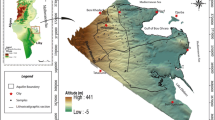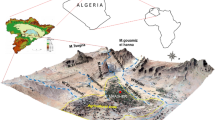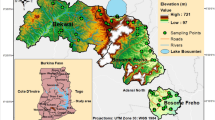Abstract
To define the potential uses of groundwater, a detailed hydrochemical analysis was carried out in the Kučaj–Beljanica Massif at seven locations, in the eastern part of the Republic of Serbia. The hydrogeochemical analysis led to a better understanding of the hydrogeochemical processes occurring underground, as well as the existence and origin of groundwater heat sources. The chemical composition of the thermal groundwater indicates different formation conditions, the influence of different rock types and different physico-chemical processes with time and temperature variations on water quality. Better insight into the geochemical and thermal conditions of groundwater can identify the most prospective locations for geothermal applications such as indoor and outdoor space heating, sports, recreation and tourism, as well as industrial applications, with or without the additional use of heat pumps. Factor analysis (FA), especially principal component analysis (PCA) and cluster analysis (CA) were applied for the evaluation of the spatial/temporal variations of Kučaj–Beljanica thermal groundwater. It was concluded that PCA was the optimum method for explaining functional relationships between the chemical elements. After data reduction, three main factors controlling variability were identified. Hierarchical cluster analysis (HCA) was applied for sample differentiation according to sample location which resulted in the grouping of the examined location into three main groups according to their thermal or geochemical potential: Group I: lowest potential for any purpose; Group II: best thermal potential (wellness centres, agriculture and heating of different facilities and Group III: specific hydrogeochemical potential suitable for bottling or balneal tourism.









Similar content being viewed by others
References
Banks D, Sletten RS, Haldorsen S, Dale B, Heim M, Swensen B (1998) The thermal springs of Bockfjord, Svalbard: occurrence and major ion hydrochemistry. Geothermics 27(4):445–467
Borgese L, Federici S, Zacco A, Gianoncelli A, Rizzo L, Smith DR, Donna F, Lucchini R, Depero LE, Bontempi E (2013) Metal fractionation in soils and assessment of environmental contamination in Vallecamonica, Italy. Environ Sci Pollut Res 20:5067–5075
Brkić Ž, Briški M, Marković T (2016) Use of hydrochemistry and isotopes for improving the knowledge of groundwater flow in a semiconfined aquifer system of the Eastern Slavonia (Croatia). CATENA 142(2016):153–165
Celati R, Grassi S, D’Amore F, Marcolini L (1991) The low temperature hydrothermal system of Campiglia, Tuscany (Italy): a geochemical approach. Geothermics 20(1–2):67–81
Fernández-Martínez M, Margalef O, Sayol F, Asensio D, Bagaria G, Corbera J, Sabater F, Domene X, Preece C (2019) Sea spray influences water chemical composition of Mediterranean seminatural springs. CATENA 173(2019):414–423
Ford D, Williams P (1989) Karst geomorphology and hydrology. Caphman & Hall, London (ISBN 0 412 44590 5)
Grubbs F (1969) Procedures for detecting outlying observations in samples. Technometrics 11(1):1–21
Hitchon B (1999) Introduction to ground water geochemistry. Geoscience Publishing Ltd, Alberta
Kaiser H (1960) The application of electronic computers to factor analysis. Educ Psychol Meas 20:141
Luo J, Rohna J, Bayerb M, Priess A, Wilkmanna L, Xiangc W (2015) Heating and cooling performance analysis of a ground source heat pump system in Southern Germany. Geothermics 53:57–66
Manly B (2000) Multivariate statistical methods A primer, 2nd edn. Chapman & Hall/CRC, New York, p 97
Martínez-Santos M, Probst A, García-García J, Ruiz-Romera E (2015) Influence of anthropogenic inputs and a high-magnitude flood event on metal contamination pattern in surface bottom sediments from the Deba River urban catchment. Sci Total Environ 514:10–25
Milenić D, Vranješ A (2015) Istraživanje i valorizacija subgeotermalnih energetskih resursa, Monograph, Faculty of mining and geology. University of Belgrade, Belgrade
Milenić D, Vasiljević P, Vranješ A (2010) Criteria for use of groundwater as renewable energy source in geothermal heat pump systems for building heating/cooling purposes. Energy Build 42(5):649–657
Piper AM (1944) A graphic procedure in the geochemical interpretation of water-analyses. Eos Trans Am Geophys Union 25(6):914–928
Piscagliaa F, Blasia A, Moroa S, Polonarac F, Arteconid A, Zanarellie L, Renzullia A (2016) Monitoring of a vertical borehole ground-coupled heat pump system: a case study from a marly-limestone heat reservoir (Urbino, Central Italy). Geothermics 62:61–69
Ragno G, De Luca M, Ioele G (2007) An application of cluster analysis and multivariate classification methods to spring water monitoring data. Microchem J 87(2):119–127
Reimann C, Birke M (2010) Geochemistry of European bottled water. Borntraeger Science Publishers, Stuttgart
Rodrigues P, Rodrigues R, Costa B, Tavares MA, Esteves da Silva J (2010) Multivariate analysis of the water quality variation in the Serra da Estrela (Portugal) Natural Park as a consequence of road deicing with salt. ChemomIntell Lab Syst 102(2):130–135
Shrestha S, Kazama F (2007) Assessment of surface water quality using multivariate statistical techniques: a case study of the Fuji river basin. Jpn Environ Modell Softw 22(4):464–475
Stevanović Z (1991) HidrogeologijakarstaKarpato-balkanidaistočneSrbije i mogućnostivodosnabdevanja. Monograph, Department of hydrogeology, Faculty of mining and geology, Belgrade
Stevanović Z, Ristić VV, Milanović S, Lj V, Petrović B (2011) Značajmonitoringapodzemnihvoda u karstuSrbije, Zbornikradovasa 7. Simpozijuma o zaštitikarsta, BelaPalanka
Stojković J. (2013) Hidrogeohemijska valorizacija esencijalnih mikroelemenata мineralnih voda Srbije, Doctoral dissertation, Department of hydrogeology, Faculty of mining and geology, Belgrade
Tabachnick BG, Fidell LS (2007) Using multivariate statistics, 5th edn. Allyn and Bacon, New York
Varol M, Gokot B, Bekleyen A, Sen B (2012) Spatial and temporal variations in surface water quality of the dam reservoirs in the Tigris River basin, Turkey. CATENA 92:11–21
Vasić LJ (2017) Geneza i uslovi cirkulacije voda kompleksnih karstnih sistema Kučajsko-beljaničkog masiva, Doctoral dissertation, Department of hydrogeology, Faculty of mining and geology, Belgrade
Yurteri C, Simsek S (2017) Hydrogeological and hydrochemical studies of the Kaman-Savcili-Büyükoba (Kirsehir) geothermal area, Turkey. Geothermics 65:99–112
Živojinović D, Rajaković-Ognjanović V, Onija A, Rajaković LJ (2013) Spatial variations in the distribution of trace ionic impurities in the water-steam cycle in a thermal power plant based on a multivariate statistical approach. Central Eur J Chem 11(9):1456–1470. https://doi.org/10.2478/s11532-013-0286-4
Acknowledgements
This paper was supported by projects of Serbian Ministry of science and education (OI 107022 and TR37005) and by projects of the China Geological Survey (Grant nos. 12120113005300), from the National Key Research Projects (Grant no. 2016YFC05025).
Author information
Authors and Affiliations
Corresponding author
Additional information
Publisher's Note
Springer Nature remains neutral with regard to jurisdictional claims in published maps and institutional affiliations.
This article is a part of a Topical Collection in Environmental Earth Sciences on Sustainable Management of Karst Natural Resources, guest edited by Drs. Sasa Malinovic and Zoran Stevanovic.
About this article
Cite this article
Vasić, L., Živojinovic, D.Ž., Rajaković-Ognjanović, V. et al. The subthermal potential of karstic groundwater of Kučaj–Beljanica region in Serbia estimated by the multivariate analysis. Environ Earth Sci 80, 120 (2021). https://doi.org/10.1007/s12665-021-09392-1
Received:
Accepted:
Published:
DOI: https://doi.org/10.1007/s12665-021-09392-1




